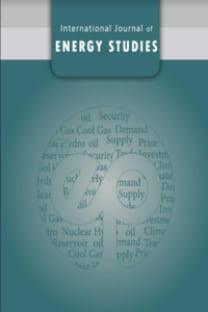Production and determination of properties of ethanol from mango and orange peels
Production and determination of properties of ethanol from mango and orange peels
Bioethanol IC engines, Fossil fuel, Mango peels, Orange peels,
___
- [1] Mshelia RB. Assessment of renewable energy potentials of the northeast geopolitical region of Nigeria. Renewable Energy Sources, Energy Policy and Energy Management 2021; 2(2): 24–38.
- [2] Nwosu-Obieogu K, Chiemenem L, Adekunle K. Utilization of agricultural waste for bioethanol production-a review. International Journal of Current Research and Review 2016; 8(19): 1-5.
- [3] Yusuf AA, Inambao FL. Bioethanol production from different Matooke peels species: A surprising source for alternative fuel. Case Studies in Thermal Engineering 2019; 13: 100357.
- [4] Reddy LV, Reddy OVS, WeeYJ. Production of ethanol from mango (Mangifera indica L.) peel by Saccharomyces cerevisiae CFTRI101. African Journal of Biotechnology 2011; 10(20): 4183–4189.
- [5] Sarkar N, Ghosh SK, Bannerjee S, Aikat K. Bioethanol production from agricultural wastes: An overview. Renewable Energy 2012; 37(1): 19–27.
- [6] Chaudhary A, Hussain Z, Aihetasham A, El-Sharnouby M, Rehman RA, Khan MAU, Alhazmi A. Pomegranate peels waste hydrolyzate optimization by response surface methodology for bioethanol production. Saudi Journal of Biological Sciences 2021; 28(9): 4867–4875.
- [7] Maina M, Oluwole F, Ngala G, Abdulrahman S. Comparism of the properties and yield of bioethanol from mango and orange waste. Arid Zone Journal of Engineering, Technology and Environment 2017; 13(6): 779.
- [8] Orozco RS, Hernández PB, Morales GR, Núñez FU, Villafuerte JO, Lugo VL, Vázquez PC. Characterization of lignocellulosic fruit waste as an alternative feedstock for bioethanol production. BioResources 2014; 9(2): 1873–1885.
- [9] Sarao LK, Kaur S, Kaur P, Bakala HS. Production of bioethanol from fruit wastes: recent advances. Food Waste to Green Fuel: Trend & Development 2022; 213–253.
- [10] Tahir M, Sagir M, Suleman S, Abbas N, Al-Malik A, Tanveer M, Pan X. Regional potential of pectin and bioethanol productionfrom fruit waste (peels of citrus and mango): Case study waste to product at Pakistan. Journal of the Pakistan Institute of Chemical Engineers 2017; 45(1): JPIChE-45.
- [11] Arshad M, Zia MA, Shah FA, Ahmad M. An overview of biofuel. Perspectives on Water Usage for Biofuels Production 2018; 1–37.
- [12] Alhassan AG, Mshelia RB, Yusuf R. Review of the use of bioethanol as alternative fuel for internal combustion engines. Acta Technica Corviniensis-Bulletin of Engineering 2021; 14(2): 139–144.
- [13] Matharasi A, Uma C, Sivagurunathan P, Sampathkumar, P. Determination of bioethanol potential from banana waste using indigenous yeast (Saccharomyces cerevisiae. KX033583). Journal of Pharmacognosy and Phytochemistry 2018; 7(5): 2661–2669.
- [14] Rezania S, Oryani B, Cho J, Talaiekhozani A, Sabbagh F, Hashemi B, Parveen FR, Mohammadi AA. Different pretreatment technologies of lignocellulosic biomass for bioethanol production: An overview. Energy 2020; 199: 117457.
- [15] Ademiluyi F, Mepba H. Yield and properties of ethanol biofuel produced from different whole cassava flours. International Scholarly Research Notices, 2013.
- [16] Obeta JC, Ossai EC, Njoku OU. Optimization and characterization of bioethanol production from Abrus seed flour. International Journal of Energy Research 2021; 45(3): 3883–3898.
- [17] Aparicio E, Rodríguez-Jasso RM, Pinales-Márquez CD, Loredo-Treviño A, Robledo-Olivo A, Aguilar CN, Kostas ET, Ruiz HA. High-pressure technology for Sargassum spp biomass pretreatment and fractionation in the third generation of bioethanol production. Bioresource Technology 2021; 329: 124935.
- [18] Akram F, ul Haq I, Imran W, Mukhtar H. Insight perspectives of thermostable endoglucanases for bioethanol production: A review. Renewable Energy, 2018; 122: 225–238.
- [19] El‐Mashad HM, Zhang R. Advances in Plant‐Based Waste‐to‐Energy Conversion Technologies. Byproducts from Agriculture and Fisheries: Adding Value for Food, Feed, Pharma, and Fuels 2019; 369–402.
- Yayın Aralığı: Yılda 4 Sayı
- Başlangıç: 2016
- Yayıncı: Türkiye Enerji Stratejileri ve Politikaları Araştırma Merkezi (TESPAM)
Decontamination applications in primary circuit equipment of nuclear power plants
The challenges and serviceability of solar power: suggestion on solving the Nigeria energy crisis
Ayşe TANSU, Ayomide Titus OGUNGBEMİ, Fatma TANSU HOCANIN
Production and determination of properties of ethanol from mango and orange peels
Anas BALA, Richard Balthi MSHELİA, Jamilu Ya'u MUHAMMAD, M ADAM
